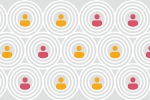Subscribe to Disclose
In the spotlight: Digital transformation
Driving digital transformation ahead
Dr. Michael Abresch
Partner, Leader Assurance Transformation, PwC Switzerland
COVID-19 has brought a great deal of uncertainty. A future-oriented audit harnessing digital technologies and tools can help restore security and trust, as well as giving companies the opportunity to recognise and capitalise on the positive aspects of the pandemic.
Digital transformation started long before the advent of COVID-19. The outbreak of the pandemic merely accelerated the process. Many businesses were forced to adopt basic technologies such as videoconferencing for the first time; others already had them in place and could start capitalising on them immediately. In most organisations homeworking, telecommuting and web-based collaboration are now a matter of routine, as are tablets, digital dialogue systems and virtual rooms (see Digitalisierung im Finanz- und Rechnungswesen 2020, PwC, 2021).
The restrictions and precautionary measures imposed during and following the pandemic have posed a whole range of new challenges for people involved in audits. Companies are having to reduce the on-site presence of staff and auditors to a minimum, access and provide current data remotely in real time, and share information with internal and external partners rapidly and securely.
Already fit for the future before COVID-19
For us auditors this situation is nothing new. We digitised our approaches and tools long before the pandemic – not only because digital fitness is crucial to our aspiration of being a leading audit firm, but also because we’re reliant on the secure and unimpeded electronic exchange of data, especially when limits to on-site presence make access to physical records difficult or even impossible.
Our auditors have long been using technological tools and methodologies in the various phases and procedures involved in the audit. We have also developed diverse applications, some of them equipped with intelligent algorithms (see Tomorrow's audit, today!, PwC's Disclose Magazine 32, 2021). Our audit clients now benefit in multiple respects from the expertise with digital audit tools and experience we gathered during the first lockdown in early 2020. This has enabled us to complete all our audit engagements since the outbreak of COVID-19 seamlessly. Even under the new restrictions that apply to the 2021 audit seasons, companies audited by us have been able to continue working without interruption.

Aura, Connect and Halo
Aura as a new foundation
The foundation of this fitness for crisis is Aura, the platform used for every PwC audit worldwide. This application enables the audit plan to be tailored to the business of the audited company and executed consistently. Aura is designed so that audit planning starts with the client’s own assessment and evaluation of the risks, modelling elements such as the control environment, the capture of specific risks and even quantitative considerations. Thanks to digitised documents, repetitive work steps can be standardised. In sum, Aura assures the quality and uniformity of the audit.
Closely connected with Connect
Another key technology reduces the complexity of sharing information with the audit client to a single concept: Connect. This web-based collaboration platform guarantees the rapid, efficient and secure exchange of information at every phase of the audit. Connect monitors the exchange of documents in real time and enables both auditors and their clients to track progress at all times via their PC, tablet or smartphone, wherever they’re located. Connect is especially useful because it shows everyone involved in the audit process what’s already been completed, what’s still pending, who’s responsible, and what tasks absolutely have to be done on premises.
Identifying anomalies with Halo
Thanks to data analytics it’s possible to aggregate and combine audit-relevant data intelligently. This allows the identification of risks at the transaction and master data level and the detection of anomalies in the course of the year and in real time. This helps auditors when it comes to assessing risks and selecting the appropriate audit strategy and procedures. PwC’s Halo technology scrutinises entire accounting data sets for anomalies (for example account relationships, transactions, timing of booking and accounting logic). The audit used to be a systematic analysis of business processes on the basis of samples. With Halo it’s a closely meshed linkage of process flows and the relevant internal controls to generate fully fledged audit assertions through 1,500 audit algorithms. This enables PwC’s auditors to audit in considerably more depth and concentrate on high-risk anomalies. It also eliminates the sampling risk. Last but not least, the accompanying potential analysis, including visualisation of end-to-end data flows, shows the audit client where there’s room for optimisation.

Evolving and connecting
The most striking development during the pandemic was an increased shift from analogue to digital audits. This process of digitalisation increases the cyber-risks and the need to protect data more effectively (see COVID-19 throws the spotlight on data, PwC's Disclose Magazine 32, 2021). This means that one feature of the post-COVID landscape will be that tools will be even more closely interconnected and evolved to create secure, high-performance, intelligent digital ecosystems. PwC’s Aura and Connect tools, for example, are now closely linked. For instance documents sent electronically by clients are transferred directly into the audit documentation without the need for manual downloads or uploads, giving the audit team access to all the documents intended for them in Aura. This facilitates the transfer of data between the tools and optimises collaboration between the client and the auditors, from requests for documents to the audit documentation.
Sustained benefits
Digital audit technologies such as Aura and Connect provide attractive benefits as the result of tireless transformation: The audit can be conducted without interrupting operational business, even under more difficult conditions such as those created by COVID-related constraints. The client has greater confidence in the validity of the audited data, something that’s particularly relevant when it comes to making decisions in times of such uncertainty. Last but not least, clients derive even greater benefit from the expertise of the audit team in matters that require a face-to-face encounter; for example to discuss audit findings or suggested improvements, assessing observations in control audits or professional exchange per se.
Summary
It’s hard to make predictions in times of such uncertainty. But what we can say for sure is that the future of the audit will be digital. At progressive companies and leading audit firms this has increasingly been the case for some time. Digital transformation will continue after COVID-19. Ideally clients and their auditors should be embarking on this journey hand in hand. Thanks to the latest communication and collaboration platforms, this interpersonal exchange can naturally be virtual.
The harmonious interplay of people and technology creates solutions for tackling coming crises and exploits the increasingly sophisticated possibilities of digital. We’re contributing to this development by refining and connecting our digital audit tools on an ongoing basis. At the same time, we’re helping our auditors perfect their sensitivity and skills when it comes to addressing the needs of their clients and adapting their audit approaches in line with their digital maturity. This includes personal dialogue on key topics, insights and issues. Dialogue between people remains crucial to the success of digital audits (see Digitale Prüfung heute und morgen: Ausschlaggebend ist nicht (nur) die Technologie, PwC, 2020).
#social#
Contact us
Partner, Leader Digital Assurance & Trust and Cybersecurity & Privacy, PwC Switzerland
+41 58 792 84 59






